Titan Fenrir Siberia Edition CPU Cooler Review

Titan Company decided to join the ranks of the super-cooler makers and introduced a massive and ambitious CPU air-cooler. The cooler looks indeed very impressive, but will it be able to deliver high cooling efficiency at a low level of noise?
It is really hard to believe but 7-8 years ago, when no one even heard about Scythe or Thermalright, and Phanteks and Noctua didn’t even exist, the Taiwanese TITAN Technology Limited was one of the leaders in entry-level as well as super-efficient processor cooling systems. Although their famous “butterfly-coolers” Vanessa S- and L-type and a thermo-electrical Amanda TEC weren’t absolutely issue-free, they won many overclockers’ hearts. After that the company’s progress slowed down for some reason, there were no new interesting ideas on the cooling front, plus numerous competitors have reached such serious pace that Titan still has hard time catching up with them up until now.
Nevertheless, today we are going to talk about this particular company and its coolers. And the main reason for that is their new Fenrir Siberia Edition CPU cooler, which the flagship product in Titan’s CPU cooler line-up.
I have to mention that Titan already has a few Fenrir tower-coolers in their product range. For example, the original Fenrir, beautiful Fenrir Christmas Edition, or golden Fenrir EVO with copper inserts. However, our today’s hero takes a special spot in this lineup, as it is not only the most expensive Titan cooler, but also the most unique one, which we haven’t seen by Titan before.
Packaging and Accessories
The cardboard box of the new cooler is very large and heavy that is why a plastic carry-handle comes in really handy here:
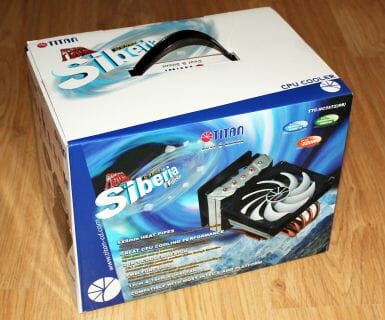
There is a photograph of the cooler on the front of the box together with the model name, the description of the key features and a mention of the fact that Fenrir Siberia Edition is capable of handling up to 220 W CPUs. However, these numbers in the coolers specifications do not really mean much, as a rule.
The package sides and back flaps describe all the same features but in a little bit greater detail, with illustrations and in eight different languages, some translations being very entertaining to read:
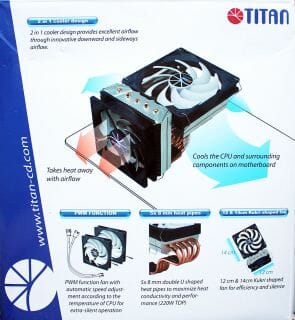
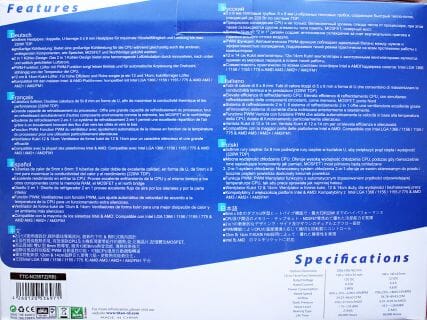
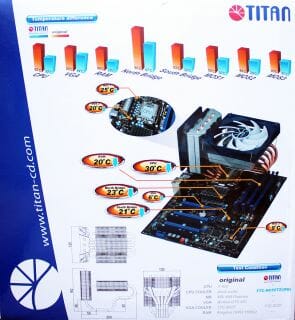
Inside the cardboard box there is a clear plastic blister molded precisely following the shape of the heatsink and fans, which are firmly affixed on the heatsink. This double-packaging will minimize possible transportation damages. There is a separate smaller box with accessories including the following items:
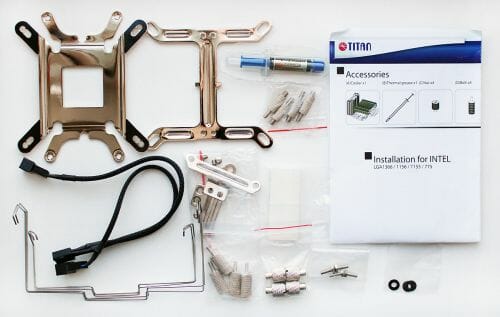
- Universal backplate;
- Universal retention bracket;
- Y-cable for the fans;
- Two pairs of wire clips for attaching the fans;
- A set of washers, bushes, screws and thumb-screws;
- A step-by-step guide on how to assemble and install the cooler;
- Titan Royal grease.
- Mainboard: Intel Siler DX79SI (Intel X79 Express, LGA 2011, BIOS 0380 from 11/28/2011);
- CPU: Intel Core i7-3960X Extreme Edition, 3.3 GHz, 1.2 V, 6 x 256 KB L2, 15 MB L3 (Sandy Bridge-E, C1, 32 nm);
- Thermal interface: ARCTIC MX-4;
- Graphics card: Asus Radeon HD 6770 DirectCU Silent (EAH6770 DCSL/2DI/1GD5) GDDR5 128 bit, 850/4000 MHz (with a passive heatsink from the DeepCool V4000 VGA cooler);
- System memory: DDR3 4 x 4GB Mushkin Redline (Spec: 2133 MHz / 9-11-10-28 / 1.65 V);
- System drive: Crucial m4 256 GB SSD (SATA-III,CT256M4SSD2, BIOS v0009);
- Drive for programs and games: Western Digital VelociRaptor (300GB, SATA-II, 10000 RPM, 16MB cache, NCQ) inside Scythe Quiet Drive 3.5” HDD silencer and cooler;
- Backup drive: Samsung Ecogreen F4 HD204UI (SATA-II, 2 TB, 5400 RPM, 32 MB, NCQ);
- System case: Antec Twelve Hundred (front panel: three Noiseblocker NB-Multiframe S-Series MF12-S2 fans at 1020 RPM; back panel: two Noiseblocker NB-BlackSilent PRO PL-1 fans at 1020 RPM; top panel: standard 200 mm fan at 400 RPM);
- Control and monitoring panel: Zalman ZM-MFC3;
- Power supply: Xigmatek “No Rules Power” NRP-HC1501 1500 W (with a default 140 mm fan).
- LinX AVX Edition version 0.6.4 – to load the processor (memory – 4500 MB, Problem Size – 24234, two 11-minute cycles);
- Real Temp GT 3.70 – to monitor the processor core temperatures;
- Intel Extreme Tuning Utility version 3.0 – for monitoring and visual control of all system parameters during overclocking.
The cooler is manufactured in China and costs… $90! This is how Titan managed to jump from “3-cent fans” to a price segment, where CPU air-coolers can be counted with the fingers of one hand. The cooler comes with a one-year warranty.
Design and Functionality
The most remarkable part of Titan Fenrir Siberia Edition cooler is certainly its heatsink. This is what we are going to start with:
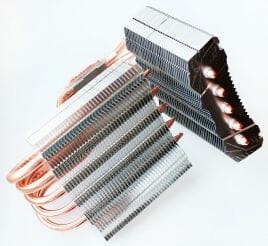
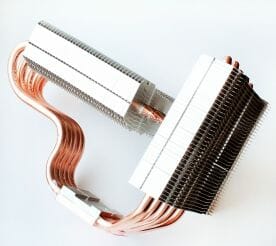
True, the newcomer’s heatsink looks very unusual, as it consists of two individual fin arrays positioned at a 90-degree angle to one another. One of them is positioned vertically (as a regular tower) and another one – perpendicular to it:
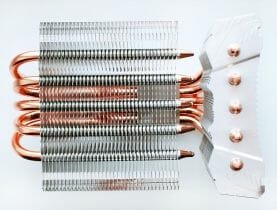
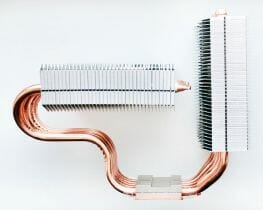
At the same time I have to point out that both arrays are identical in size and shape. Each of them consists of 38 aluminum fins 0.4 mm thick that are pressed against the heatpipes at 2.2 mm distance from one another. The sides of the fins are bent creating sort of a tunnel and concentrating the airflow around the heatpipes and fins.
The heatsink weighs 775 grams, which is not too much, according to today’s standards in the super-cooler as well as in regular cooler segment. The total effective surface size is also relatively small – 7,400cm2, which is quite modest. However, the overall heatsink size is 200x130x162 mm.
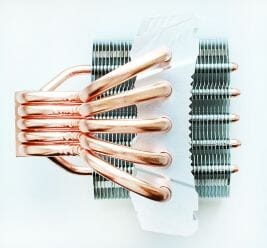
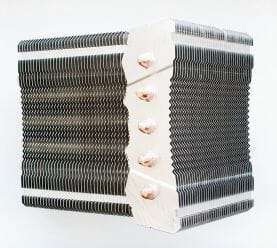
Titan Fenrir Siberia Edition is built on five copper heatpipes 8 mm in diameter that go through the copper base plate and evenly pierce each of the heatsink arrays:

Regretfully, we have to admit that the heatsink fins are simply pressed against the heatpipes: there are no traces of thermal glue or soldering:
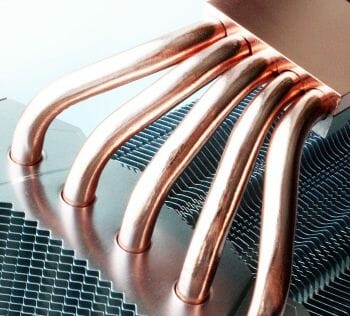
The same is true of the base: we didn’t see any soldering traces there, either, so we dare assume that they use some kind of thermal glue there. Unfortunately, this is the least efficient contacting method.
The base of 45×40 mm large and is exceptionally finished, although not polished at all:
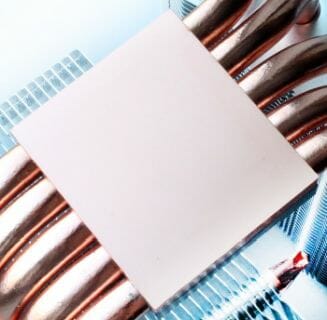
It is impeccably even and the thermal paste imprints came out decent:
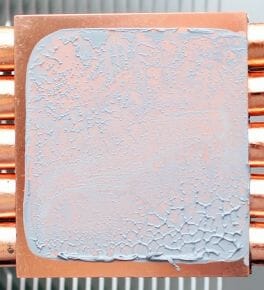
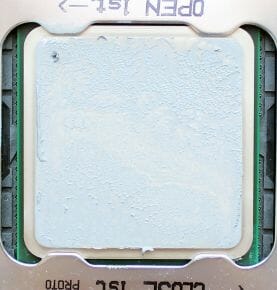
Titan Fenrir Siberia Edition is equipped with two Kukri fans: TFD-14025H12ZP/KU (RB) and TFD-12025H12ZP/KU (RB) models. They have 11 long sickle-shaped blades:
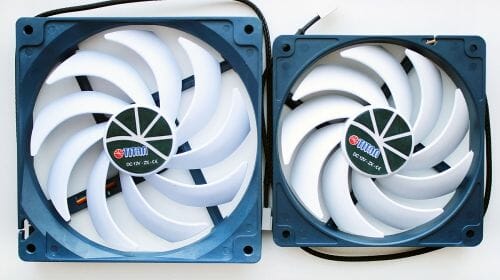
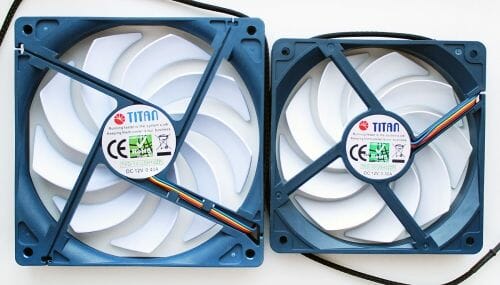
The marking indicates clearly that one of the fans is 140x140x25 mm big, and another – 120x120x25 mm big. Both fans support PWM rotation speed adjustment in the following intervals: 700-1800 RPM for the 140 mm model and 800-2200 RPM for the 120 mm model. Both fans use an enhanced sleeve bearing with threading inside (referred to as Z-axis by Titan). It should last 60,000 hours or over 6.8 years, which is twice as much as what a conventional sleeve bearing is capable of. The four-pin cables are 375 mm long.
The electrical specifications of the fans are very similar. For example, their maximum power consumption shouldn’t exceed 4.8 W for the 140 mm fan and 3.84 W for the 120 mm fan:
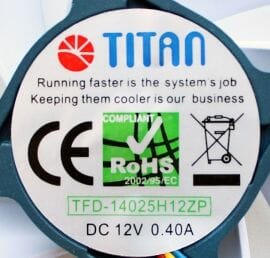
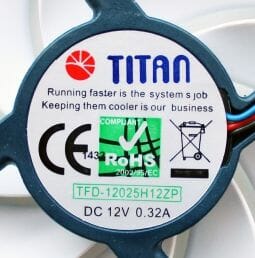
Other specifications of the Kukri fans are provided in our technical specifications summary table below. Here I would only like to add that each of the fans is attached to the heatsink with a pair of wire clips, which catch on to the special retention holes in the fan frames and then to the grooves in the heatsink:
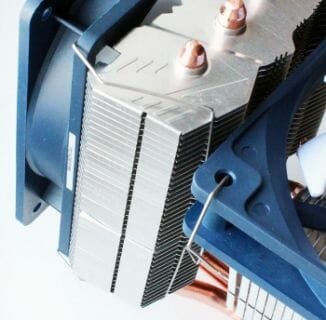
For vibration absorption you should use short silicone strips inserted into the grooves in the heatsink:
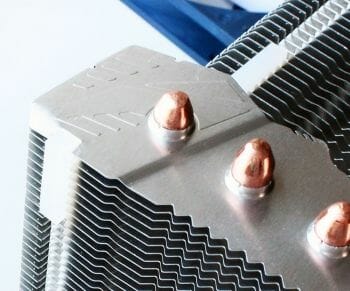
The large 140 mm fan goes onto the horizontal heatsink array and it will be directly the airflow towards voltage regulator components around the CPU socket, the chipset and the memory DIMMs:
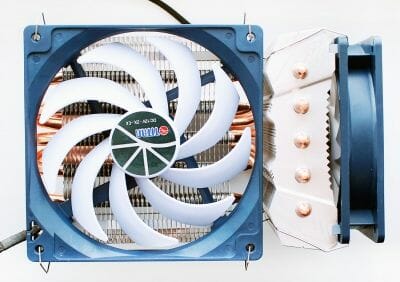
As for the 120 mm fan, it is installed on the external side of the vertical heatsink array directing the airflow away from the heatsink. In other words, it will be “sucking out” the hot air from the heatsink, where it is sent by the horizontal fan. We got the feeling that Titan Fenrir Siberia Edition developers were mostly concerned with cooling the components around the CPU socket rather than with cooling the actual CPU. This approach has never been a winning one: the CPU wasn’t cooled properly and there was really not much benefit from cooling the around-the-socket components. But what if Titan engineers managed to work wonders this time? Well, we are going to find out shortly, and in the meanwhile, let’s see how easily we will be able to mount Titan Fenrir Siberia Edition onto a mainboard.
Compatibility and Installation
It was very difficult to imagine that an air-cooler costing as much as a mainstream processor could be incompatible with any of the platforms. Luckily, it isn’t the case and you can install Titan Fenrir Siberia Edition onto any of the contemporary (and even not very contemporary) mainboard. The installation procedure is described in detail on the official company web-site. In general, it is the same for all platforms, because you will be using the same backplate and retention bracket except for the LGA 2011 systems, where you will have to use double-sided threaded bushes, which should go into the socket retention holes:
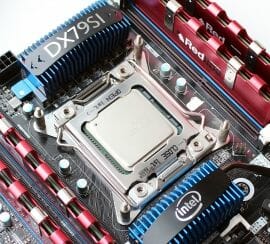
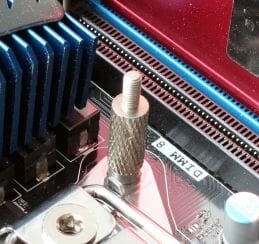
After that you have to apply a layer of thermal paste, install the cooler and evenly tighten the thumb-screws on top of the retention bracket:
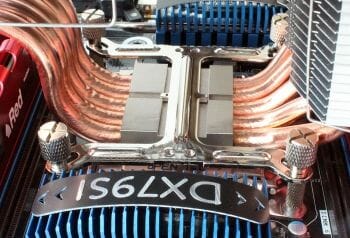
The retention provides very high pressure hold, which together with crossed notches on the retention bracket and the corresponding slits in the base doesn’t let the cooler shift under its own weight.
The clearance between the mainboard and the lowest heatsink fin of the Titan Fenrir Siberia Edition cooler is 55 mm, which is more than enough to avoid any possible conflicts with the tall heatsinks on the voltage regulator components or tall memory heat-spreaders:

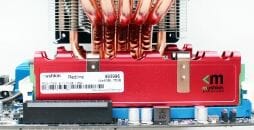
Note that the 120 mm fan on the vertically positioned heatsink array hangs about 8 mm below the heatsink, although it didn’t cause any conflicts between the memory and the cooler. This is what Titan Fenrir Siberia Edition looks like on our mainboard:
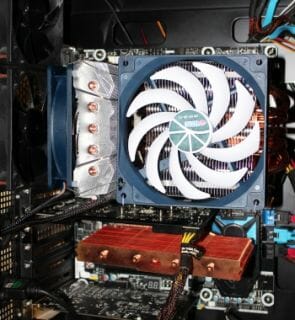
And this is what this giant looks like inside the system case:
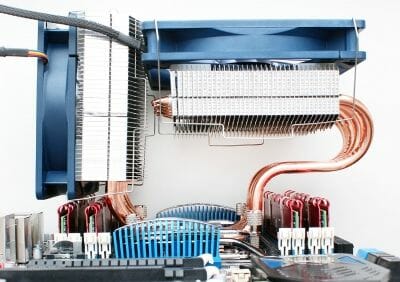
Pretty massive, but it doesn’t interfere with any components.
Technical Specifications and Recommended Pricing
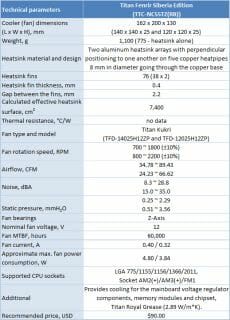
Testbed Configuration and Testing Methodology
We tested all coolers inside a closed system case with the following configuration:
For the primary tests and summary diagrams we overclocked our six-core processor with the clock generator frequency set at 125 MHz, the multiplier set at 35x and “Load-Line Calibration” enabled to 4.375 GHz. The nominal processor Vcore was increased to 1.385 V in the mainboard BIOS. After that we tested the new cooler at even higher frequency and voltage settings. Turbo Boost was disabled during this test session, and Hyper-Threading technology was enabled to increase the heat dissipation. The memory voltage was at 1.65 V and its frequency was 2000 MHz with 9-11-10-28 timings. All other parameters available in the mainboard BIOS and related to CPU or memory overclocking remained unchanged.
All tests were performed under Windows 7 Ultimate x64 SP1 operating system. We used the following software during our test session:
So, the complete screenshot during the test session looks as follows:
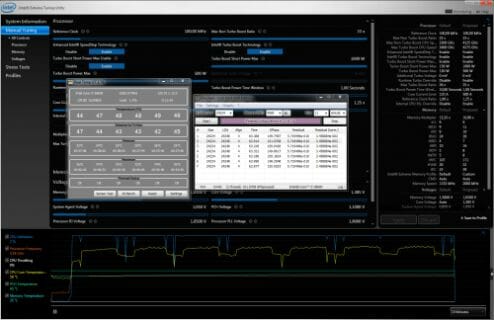
The CPU was loaded with two consecutive LinX AVX test runs with the settings as indicated above. The stabilization period for the CPU temperature between the two test cycles was about 8-10 minutes. We took the maximum temperature of the hottest CPU core for the results charts. Moreover, we will also provide a table with the temperature readings for all cores including their average values. The ambient temperature was checked next to the system case with an electronic thermometer with 0.1 °C precision that allows hourly monitoring of the temperature changes over the past 6 hours. The room temperature during our test session varied between 24.6-25.0°C.
The noise level of each cooler was measured between 1:00 and 3:00 AM in a closed room about 20 m2 big using CENTER-321 electronic noise meter. The noise level for each cooler was tested outside the system case when the only noise sources in the lab were the cooler and its fan. The noise meter was installed on a tripod and was always at a 150 mm distance from the cooler fan rotor. The tested cooling systems were placed at the edge of the desk on a sheet of polyurethane foam. The lowest noise reading our noise meter device can register is 29.8 dBA and the subjectively comfortable noise level in these testing conditions was around 36 dBA (do not mix it up with low noise level). The fan(s) rotation speed was adjusted in the entire supported range using our in-house controller by changing the voltage with 0.5 V increment.
Taking into account the size, weight and certainly the price of the new Titan Fenrir Siberia Edition ($90) we are going to compare it against Phanteks PH-TC14PE ($89) super-cooler in its default configuration with two fans:
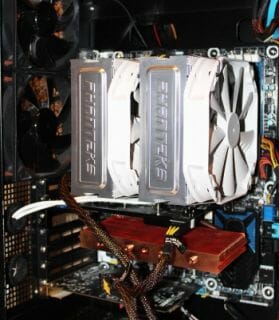
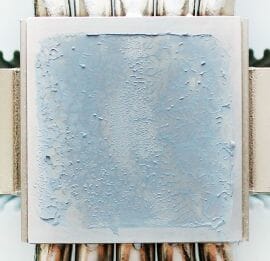
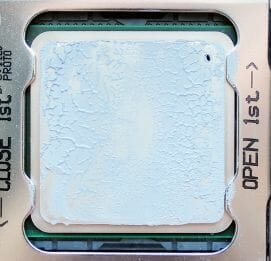
Besides the default fans, we also tested both coolers with two Scythe Slip Stream 140 fans:
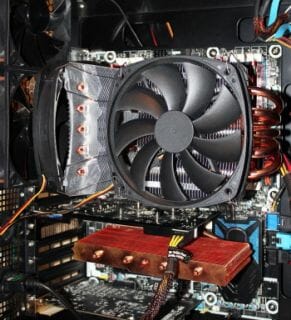
I would also like to add that the rotation speed of all fans was controlled using the same special controller as I mentioned above with ±10 RPM precision.
Well, it is time to check out how good the new Titan Fenrir Siberia Edition is.
Performance
Cooling Efficiency Tests
The results of our cooling efficiency tests are summed up in the diagram and table below:
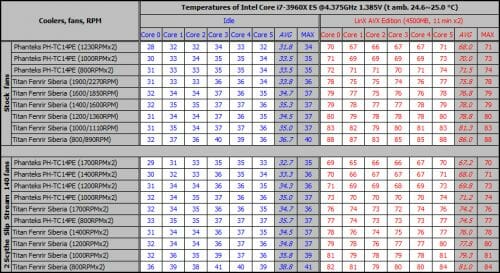
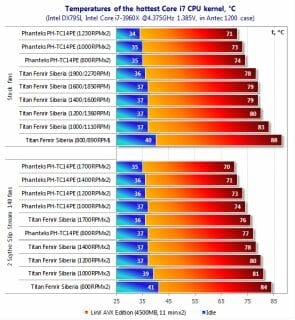
With default cooling fans Titan Fenrir Siberia Edition loses without a fight to Phanteks PH-TC14PE. Moreover, even at the maximum rotation speed of its two fans (1900/2270 RPM) it is still 4°C behind Phanteks PH-TC14PE with the fans rotating at 800 ROM. If we check out the peak CPU temperatures when the fans on both coolers rotate at the same exact speed, then the new Titan cooler will be as much as 14°C behind Phanteks. I have to admit that it isn’t an encouraging result for a cooler of this price. This is indeed unfortunate, but maybe the new Titan Fenrir Siberia Edition will do better with alternative 140 mm fans from Scythe?
True, two identical Slit Stream 140 fans improved the cooling efficiency of Titan Fenrir Siberia Edition. It still lost to the Phanteks cooler, but at the low rotation speeds of 800 and 1000 RPM the cooler started cooling 2-4°C better, at 1200 and 1400 RPM – 1-2°C better, and at the maximum speed of 1700 RPM – 2°C better. It isn’t much, but it is still noticeably better than the results obtained with the original default Titan Kukri fans. Phanteks PH-TC14PE is still 6-7°C more efficient than Fenrir Siberia Edition.
Now let’s see how Titan Fenrir Siberia Edition will rank, if we add it to our database diagram and table*, where all coolers are entered in their default configurations. We will add the results in quiet mode (800/890 RPM) and at maximum speed of both fans (1900/2270 RPM) when the CPU was overclocked to 4.375 GHz at 1.385 V core voltage:
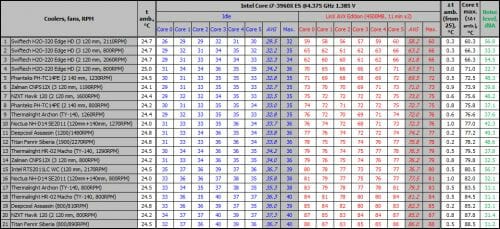
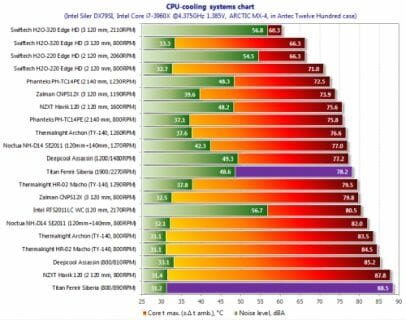
In quiet mode the 90-dollar cooler appears to be in the very last place behind all other products, which we have already tested on the new LGA 2011 platform. At the maximum fan rotation speed Titan Fenrir Siberia Edition managed to settle somewhere in the middle of the pack showing 1°C better result than Thermalright HR-02 Macho with one TY-140 fan.
During the maximum overclocking tests, Titan Fenrir Siberia Edition maintained stability of our CPU overclocked to 4.5 GHz at 1.410 V core voltage and 80°C peak temperature:
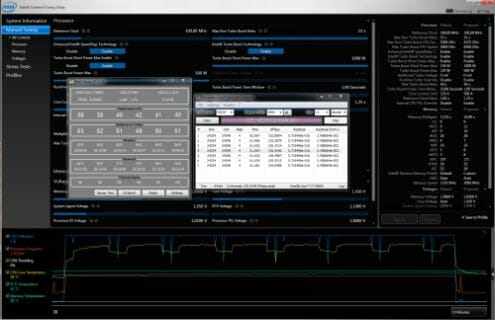
The table and diagram with maximum CPU overclocking results under each of the coolers in their default configurations place Titan Fenrir Siberia Edition somewhere in the middle between Thermalright Archon with one TY-140 fan at 1260 RPM and Noctua NH-D14 SE2011 with two fans:

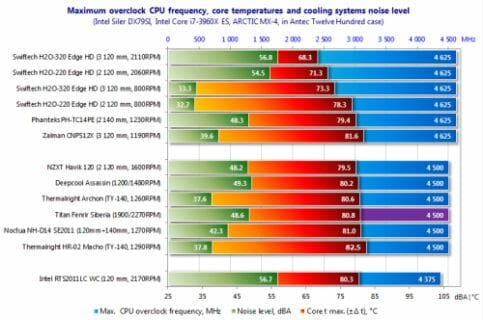
To be fair I have to say that both these coolers are quieter than Titan Fenrir Siberia Edition. So, why don’t we move on to the noise tests now?
Acoustic Performance
We measured the noise from our testing participants in the entire supported speed range of their fans following the methodology described above. The results are summed up on the following graph:

As we see, both fans of the Titan Fenrir Siberia Edition work quieter than a pair of Phanteks fans, which as we remember aren’t that quiet. They remain acoustically comfortable only up to 700-150 RPM, while the noisiest of the Fenrir Siberia fans is acoustically comfortable up to 1150 RPM. However, even this big difference in rotation speeds and noise can hardly justify the mediocre cooling efficiency of Titan Fenrir Siberia Edition, because Phanteks PH-TC14PE at 800 RPM is more effective than Titan cooler at 1900/2270 RPM. If we compare 140- and 120-mm Titan Kukri fans, we will see that the larger model is louder than the smaller one in the entire rotation speed range that is why the noise from the small fan dies in the noise from the 140 mm one. I would like to add that both fans work very softly and their rotation speed changes smoothly without abrupt transitions, crackling or electrical parasitic sounds. Here Titan did a really great job, no complaints.
Conclusion
Unfortunately, Titan Fenrir Siberia Edition turned out a disappointment. A cooler of this size, over 1 kg weight, two heatsink arrays, two fans and a 90-dollar price tag should be if not among the best CPU air-coolers, then at least be very close to them. We didn’t see that in Fenrir Siberia today, and the difference in performance with a competing super-cooler sometimes reached two digits. Pretty modest size of the effective heatsink surface, no soldering in the contact spots, not the most suitable fans – all these factors didn’t let Titan’s giant demonstrate the efficiency that would be expected from a cooler of this price. However, Titan Fenrir Siberia Edition does have a few indisputable advantages. This cooler is universal; it features very secure and reliable retention mechanism, and provides excellent cooling for the components around the CPU socket and the memory modules. Its quality fans have very good acoustic characteristics. The system is easy to put together and to install. However, all these highs do not justify its very high price. So, for now we can only cherish the memory of the titans…